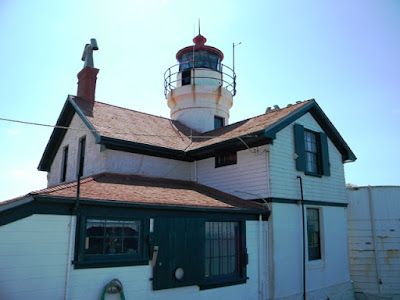
Wow, we had an incredible day in Astoria, OR while visiting the
Maritime Museum and surrounding areas. This is a must see if you are anywhere around here. The Columbia River is one of the largest rivers in the world and empties into the Pacific Ocean. As a result, this is one busy shipping/fishing area, but also features some of the most dangerous sea conditions around. Literally thousands of ships have been lost over the years to 50' (or larger) waves, currents and strong winds.

In addition to the shipping, fishing is big here. Salmon are the targeted fish and here, Rick is checking out the 60lb king salmon he would LIKE to catch.

Since this area is so important to shipping, yet so dangerous, the Coast Guard has a large presence. In fact, they average saving over 600 lives a YEAR here! This is also the location for the rigorous Coast Guard Lifeboat school -- as shown in the picture above, this is a real hands-on experience!

The museum has a special room in Coast Guard rescues (they are called out over 400 times a year here) and features this 43' rescue boat. This boat was rolled many times (and pitch-poled once) during its long career. It is self righting and one tough boat!

The Museum also offers a chance to tour the Columbia River lightship shown here. 17 crew would be on this boat anchored 5 miles off the mouth of the river for several weeks at a time. Waves well over 50' made even the most salty sailor sick. This duty is no performed by a solar powered bouy similar to the one seen above.

For living proof of a large shipwreck, all you need to do is go to the Ft. Stevens State Park and see the wreck of the Peter Iredale, which is the bow that I am standing next to above. This wreck occurred in 1906 and the 278' ship ran aground on the beach. This must be the most photographed wreck in the world.

Here is one of the many large ships we saw entering the Columbia. Passing under the Astoria Bridge, you can just see the pilot boat next to it. Crossing the bar into the river is so dangerous that ships must have a special
Columbia River Bar Pilot on board to do it. This is such a specialized skill that there are only 15 pilots who are currently licensed. Amazing!
 We enjoyed exploring Olympia, the capitol of Washington state. We arrived on a Saturday and had a great chance to tour the Capitol building which is a very impressive structure. The Capitol was completed in 1928 and is in great condition.
We enjoyed exploring Olympia, the capitol of Washington state. We arrived on a Saturday and had a great chance to tour the Capitol building which is a very impressive structure. The Capitol was completed in 1928 and is in great condition. This center light fixture (and indeed all the light fixtures) are by Tiffany and are priceless. Further, the dome structure is the fourth largest masonry dome in the world!
This center light fixture (and indeed all the light fixtures) are by Tiffany and are priceless. Further, the dome structure is the fourth largest masonry dome in the world! Orinda really enjoyed the reception room. This room and the entire capitol, were heavily damaged by an earthquake in 2001. Fortunately, they fully restored it and it is now pristine.
Orinda really enjoyed the reception room. This room and the entire capitol, were heavily damaged by an earthquake in 2001. Fortunately, they fully restored it and it is now pristine. The grounds surrounding the Capitol are equally impressive and offer many monuments and garden areas paying homage to hgihlights in Washington history.
The grounds surrounding the Capitol are equally impressive and offer many monuments and garden areas paying homage to hgihlights in Washington history. Olympia is located on the south side of Puget Sound and has a wonderful waterfront. Orinda and the wonder dog are at the start of a large boardwalk that surrounds much of the harbor.
Olympia is located on the south side of Puget Sound and has a wonderful waterfront. Orinda and the wonder dog are at the start of a large boardwalk that surrounds much of the harbor. We enjoyed walking along the harbor and Rick really liked looking at the many wonderful yachts. Still, he and Cody decided they liked our land yacht better!
We enjoyed walking along the harbor and Rick really liked looking at the many wonderful yachts. Still, he and Cody decided they liked our land yacht better!

 T
T











































